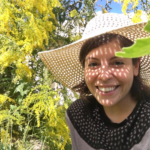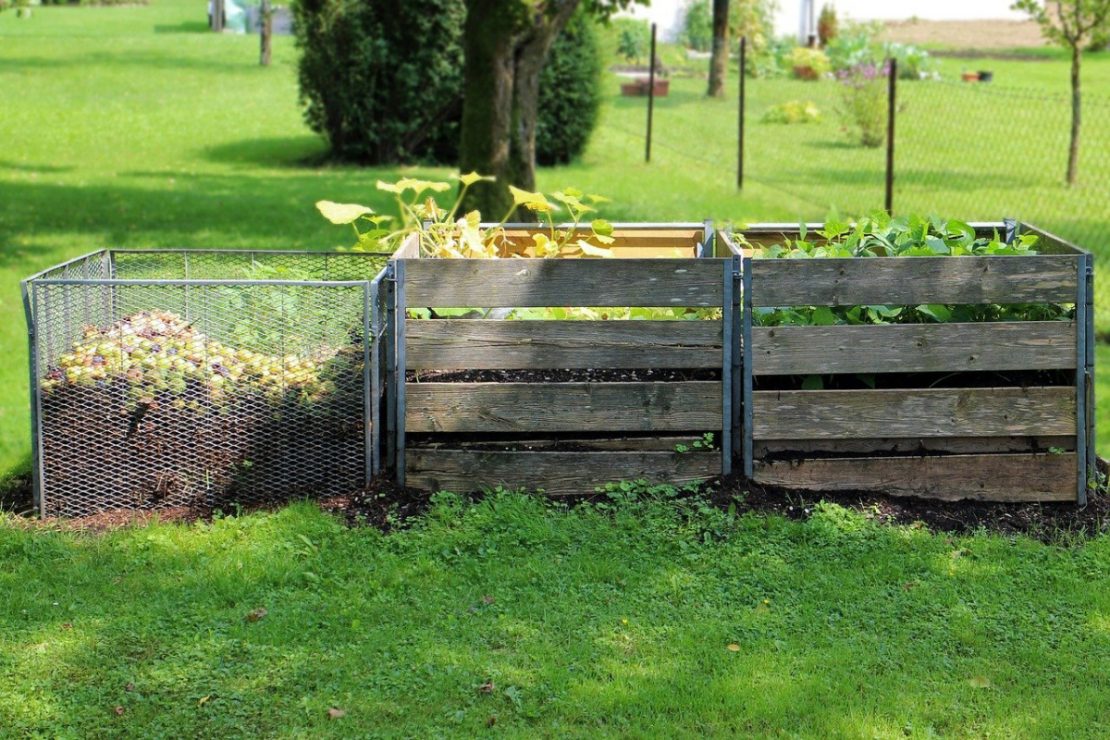
How to Compost: Getting Started Guide
Spring is finally starting to show its face in our corner of the world, and Earth Day is just around the corner. What better time to talk about ways to keep our lovely planet healthy? It may seem impossible, but each of us can make a difference, in small or large ways. “Food makes up almost 13 percent of the U.S. waste stream but a much higher percentage of landfill-caused methane” (according to this article by NRDC). One of the ways we can do our part involves turning food waste into nutrient-rich soil to plant next year’s herbs in. Composting is an easy way to increase our household sustainability, and reduce our carbon footprint. Learning how to compost is easy, and there’s plenty you can do to reduce food waste even before you start composting.
The waste hierarchy, usually known by its easy-to-remember shortened version: “Reduce, Reuse, Recycle,” tells us that the best way to keep waste out of landfills is to reduce or minimize the amount of waste produced, so let’s start there. These are all tips that can help you out before you even get to the composting step.
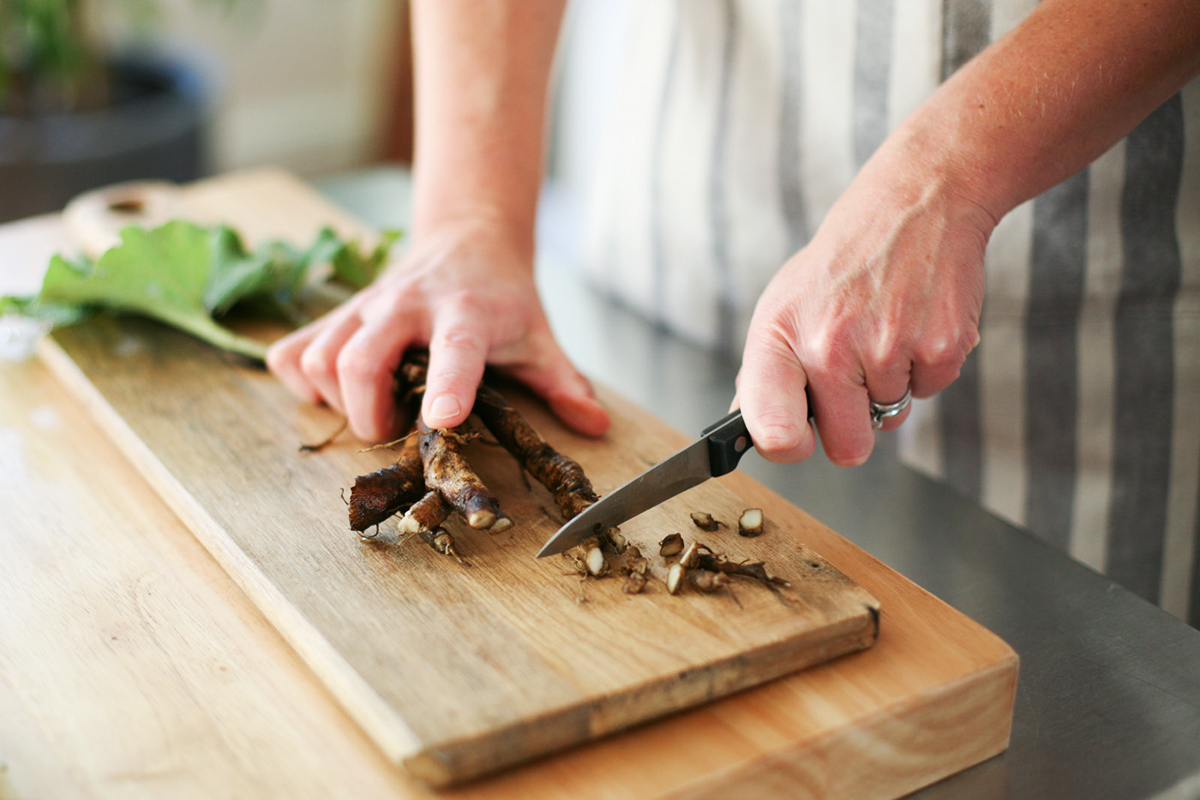
Easy Ways to Reduce Food Waste
Reduce over-purchasing of food. Letting food spoil in the refrigerator or on the counter is one of the worst feelings in the world, at least for me. So I’ve adopted a system where I plan out my meals before shopping, to ensure that everything I buy will be used in a timely manner. But even so, sometimes food goes bad. That’s where composting will come in.
Reduce waste scraps during food preparation. A good cooking class can teach you volumes about proper knife technique, and that will help you reduce the scraps down to almost nothing. Of course, almost nothing isn’t entirely nothing, so again, your compost bin will pick up the slack.
Give food a second life! This can be easy. Leftover bread becomes croutons, leftover fruit makes a great dessert topping, leftover rice can be fried and gain a second life as a delicious base for a stir-fry. Bones can become soup stock, as can vegetable trimmings. When you look at your leftovers with an eye to give them another chance, they often come out more appetizing than they did the first time. Composting will help give food its third life, as the fertile soil from which new seeds can sprout.
Sustainable practices don’t need to be difficult, and as shown above they don’t even need to take any extra effort. Composting is the next step in the reduce, reuse, recycle chain, called Recovery. We can use natural processes to recover the valuable nutrients out of our food wastes, in a number of different ways.
Composting Basics
Here are some composting basics that apply to any situation, no matter which method you choose. These basics are as important in the building stages of the compost, as they are in the maintenance stages. Referring back to these basic principles will help you get back on the right decompositional track, should your compost ever go awry.
Compost is a living thing, or actually a community of living things. It is important to keep this in mind as you approach building and maintaining a compost pile. It needs well-balanced nutrients, hydration, and air circulation. It is essential to make sure that all these components are in place, either naturally or with a little help. This will ensure that your compost thrives. If neglected, it may go inert. Like most living things, compost’s needs are basic but essential to the health and vitality of its being. When one thing is missing, or out of balance with the other pieces, it can compromise the health of the whole.
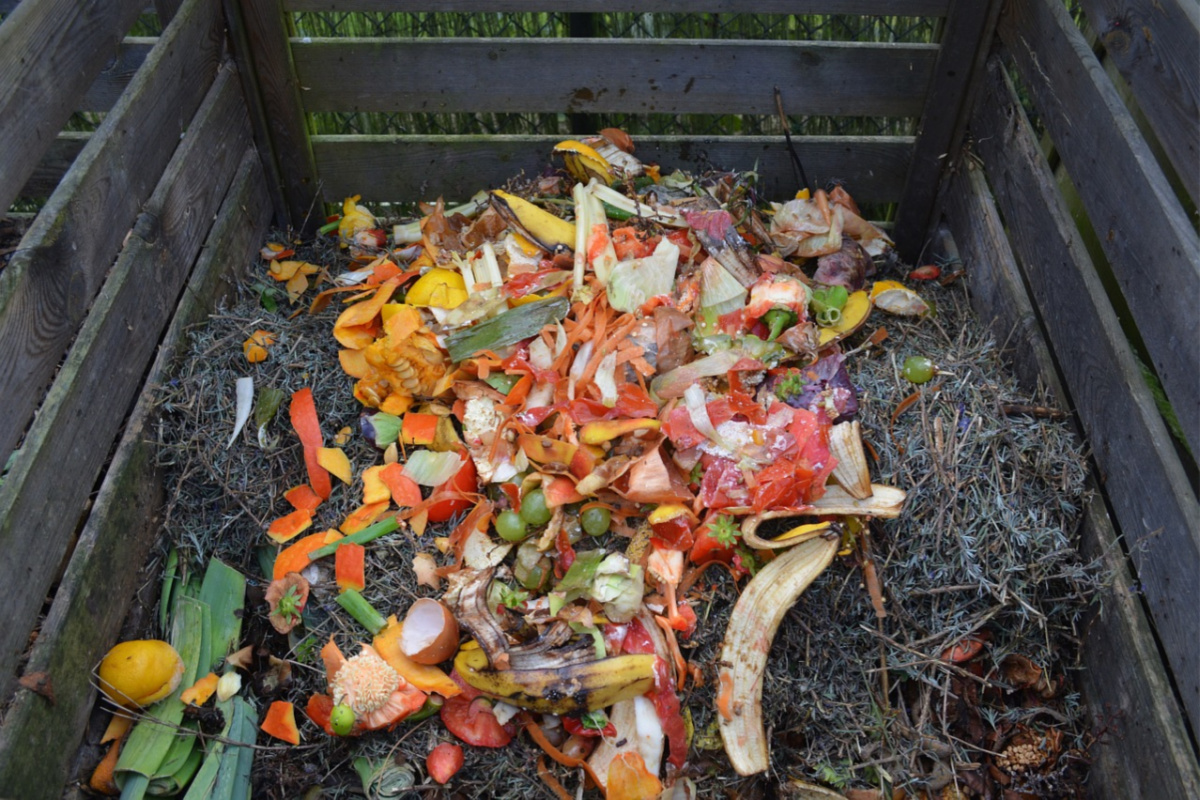
A Well-Balanced Diet
When building a compost pile, we are actually building a large habitat for the millions of fungi, bacteria, and invertebrates that do the work of decomposition. If we want a healthy community we need to provide the right diet for its population.
In the case of compost, a well-balanced diet is made up of browns and greens. “Browns” are carbon-rich wastes. Carbon is one of the basic building blocks of all life, and the main component of organic material in soil. Organic material is what helps to hold moisture in the soil. Without it, soil becomes dirt (Schwartz, 2014).
What’s the difference you may ask? While you could consider the same stuff soil when it is on the ground, or fills the pots you’re placing a seed in, dirt once it spills on your clothes or creates dust in or around your home, this is also to say soil is alive, and life-sustaining. Dirt is inert.
The other key piece in the compost diet is green things. These “greens” provide the nitrogen essential for cell growth and function (Cornell Waste Management Institute, 1996). Nitrogen is an essential soil nutrient, because without it plants can’t grow, photosynthesize, and create the chlorophyll they need to be healthy (Soil Science Society of America, n.d.).
The ideal ratio of carbon to nitrogen, or brown to green, is 30:1 carbon to nitrogen by weight. Organic material varies in its inherent carbon to nitrogen ratio, so different materials are mixed to achieve this 30:1 sweet spot (University of Maryland Extension, 2020).
Now you may be thinking to yourself, “How am I gonna measure the carbon to nitrogen ratio of what I put into my compost pile?” The good news is that you don’t have to. There are many different charts published by scientific communities that give you an overview of what is what. This one is from the University of Maryland’s College of Agriculture and Natural Resources (2020) lists wastes according to whether they are a more abundant source of carbon or nitrogen:
Carbon and Nitrogen Sources
| Carbon Sources (Browns) | Nitrogen Sources (Greens) |
| Cornstalks & corncobs
Dry leaves* Newsprint Pine needles Straw & hay Sawdust Wood chips Shrub trimmings Shredded copier paper (uncoated) *Some organic materials are initially acidic (low pH) like oak leaves. However, the composting process results in a finished product with a pH of around 7.0, or neutral pH. |
Coffee grounds
Fruit & vegetable scraps Grass clippings (untreated) Fresh hay Manure: cow, horse, poultry, sheep, rabbit Seaweed
|
(University of Maryland Extension, 2020)
With the help of this chart, you can glean some basic understanding of what waste is higher in which of these vital compost components. Then, you can begin to build your compost. It doesn’t have to be exact, so feel free to measure in shovel scoops, buckets full, or whatever other tools you have available. Essentially you’re aiming to have 30 parts of these carbon-rich waste materials to 1 part of these nitrogen-rich waste materials. An even simpler way of thinking of it is identifying whether your compost might be all carbon rich sources, such as leaves and other landscaping debris. Then you will need to add a nitrogen-rich component in a small proportion. If you’re only putting your vegetable kitchen scraps in the compost you may need to identify some carbon rich sources that you can add in heaps (proportionally to the fruit and veggies) periodically to keep your compost cooking.
The Essential Elements
Air and water are the other essential elements of starting and maintaining a decomposition community.
Keeping your compost moist will be easier in places where there is more ambient humidity, as opposed to arid locations. Depending on where you live it may or may not be necessary to wet down your compost from time to time.
If you do need to wet down your compost, use a hose attachment that will allow for a more even dispersal of water. Watering the compost weekly should be good in dryer areas or times of the year. However, don’t over-saturate your compost.
Part of the issue with over watering your compost is that you can actually drown members of your decomposition community, as they won’t have enough air to breathe. Yes, even decomposers need to breathe!
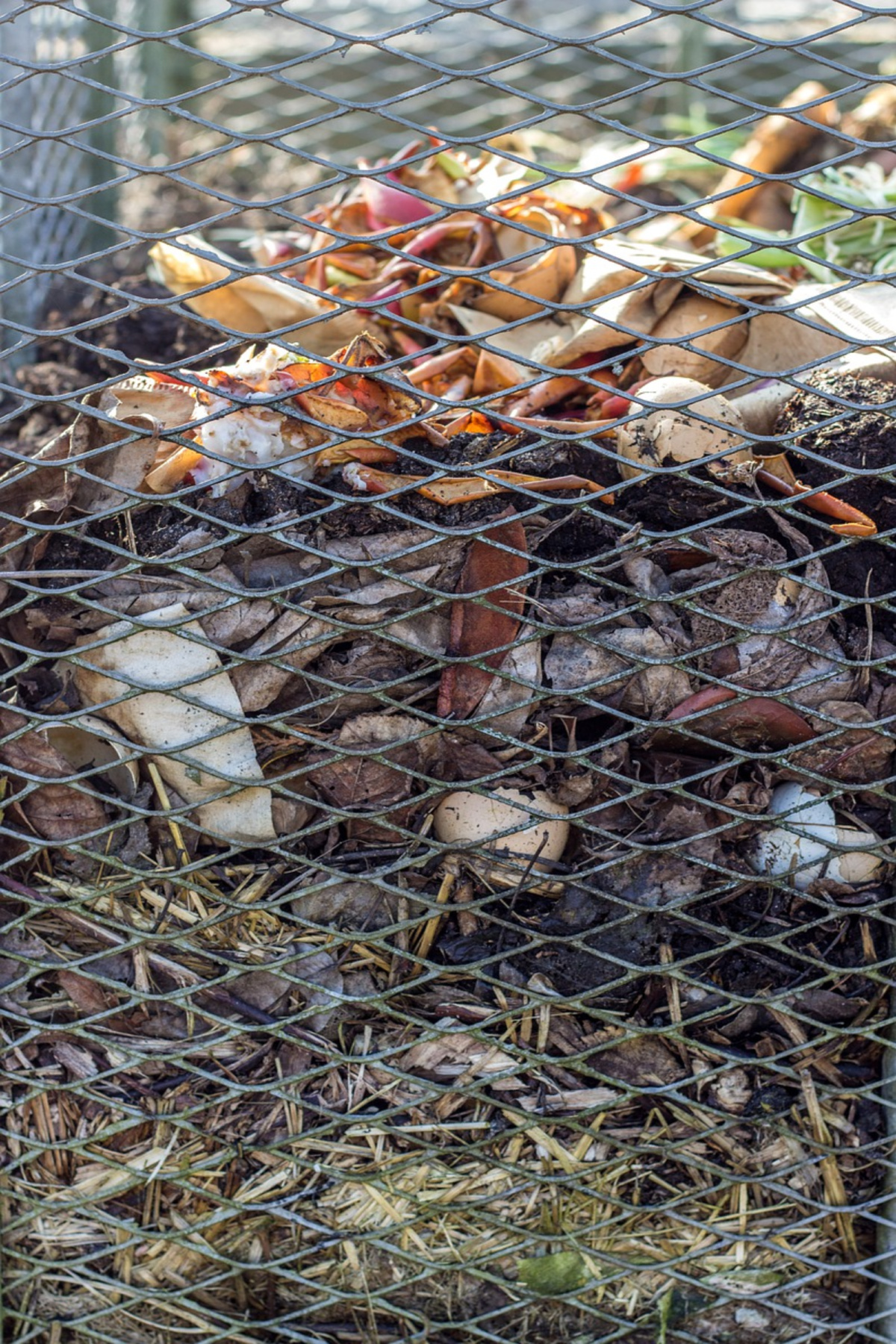
How Will I Know If I Got It Right?
Attention is the final component of creating and maintaining healthy compost. You might be surprised to know that you have the ability to communicate with your compost, or that your compost has ways of communicating with you. Not through words, but through the senses. The telltale signs of healthy compost are the smell and the temperature.
At its happiest, your compost should be warm and odor-free. If the temperature drops and/or the smell of ammonia comes wafting out of the mix, your compost is sending you signals that something is off.
Decomposition is an energy-generating process, and that energy can be felt as heat emitting from the pile. Temperatures from 130-160 degrees are optimal for the breakdown of pathogenic organisms and many weed seeds. Temperatures higher than this become stressful for helpful microbes and slows decomposition (Whatcom County Extension, n.d.).
While you can purchase a compost thermometer to temp test your compost, you can also get a feel for it by using your hand to gauge the heat and moisture of your compost. The human body temperature is on average 98.5 degrees, so a healthy compost pile will feel warm to the touch.
Simply thrust your hand into the pile, up to the wrist. If the temperature is comparable to that of hot tap water, and no foul odor wafts up when you remove your hand from the pile, all is well (University of Maryland Extension, 2020). No action is needed in this instance.
Should you thrust your hand into the pile and discover that the temperature is nearing that of your own body temperature, it is time to turn your pile. If at this time the material looks or feels dry, moisten the mixture.
If your compost feels really hot it’s time to redistribute and turn the compost. Turning alone is often not enough to bring down the temperature of an overheated pile. When possible, it is best to increase the surface area of compost to bring down the temperature.
Increasing and decreasing surface area are also great ways to respond to higher or lower atmospheric temperatures, and their effects on compost temperatures throughout the year (Whatcom County Extension, n.d.).
If, when checking your compost, you withdraw your hand from the mixture and a foul smell wafts upward, don’t panic. This happens when compost isn’t getting enough oxygen, and anaerobic decomposition kicks in. The kind of stink will determine the action you should take.
If a hot garbage smell or rotten egg smell is coming from your compost, this is likely due to compaction or overwatering. In this case, turn and increase the surface area of the pile to allow for aeration and evaporation (Chester County Solid Waste Authority, n.d.). If the smell hasn’t dissipated after a day, add more brown material and turn the compost again. This should solve the problem.
If an ammonia smell wafts up from your compost pile, you have an imbalance in your carbon to nitrogen ratio. In this instance, you have too much nitrogen to carbon. Adding in more brown material and turning the pile will alleviate the issue (Chester County Solid Waste Authority, n.d.).
Composting Options
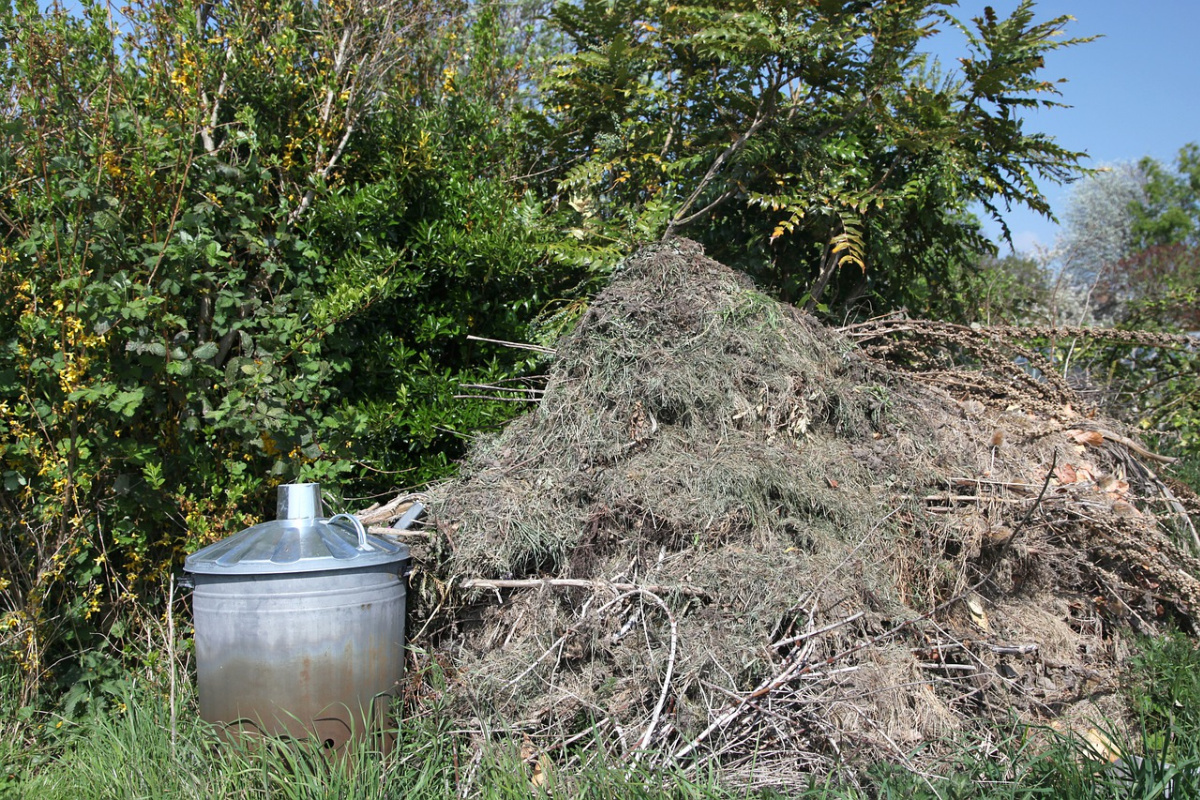
Composting Pile
A simple 3×3 pile in the corner of your yard is all you need for a traditional compost pile, but if you prefer a little more structure you can easily turn an old trash bin, some reclaimed pallets, or wire fencing materials into a compost bin (Whatcom County Extension, n.d.). Creating a bin keeps your compost neat and orderly, and will help minimize rodent access to the pile.
Once you’ve designated a spot for composting, you can begin layering your pile. Start with a base layer of carbon-rich brown material, then add a layer of nitrogen-rich green materials, followed by another layer of carbon-rich brown materials. Continue layering in this fashion; the top of the pile should be covered in carbon-rich brown materials.
From there you can continue to add in your food scraps, layer with dead leaves, and let the microbes go to work. Check on your pile regularly as you add more layers to ensure that each aspect is in balance with the others. Should issues arise, use the guide above to course correct.
One of the disadvantages of this method is that the exposure of the compost to the elements means some level of nutrient leaching is inevitable. The other is that since you are always layering the pile, the most decomposed and usable material is on the bottom of the compost heap (University of Maryland Extension, 2020).
The latter can be remedied with multi-bin system composting, which allows you to move the compost from one bin to the next as it accumulates mass. This method also moves along the decomposition process.
This looks like starting with one pile, in one bin. Once the pile fills the bin, you will transfer the pile from the full bin to the next empty bin. Transferring the pile essentially turns the whole thing from top to bottom, and inside out.
The original pile can be temperature-tested and turned as needed. This allows the original pile to further and more completely decompose, while the process begins again in the new pile.
Porch Composter
If curbside pickup isn’t an option, consider a home composting tumbler, such as this one, which can sit outside on your porch, or a patio, or in your backyard. If you’re more of a do it yourselfer, you can also make a compost tumbler like this one. These tumblers are a great solution for a few different obstacles to composting, and can help increase the accessibility of composting.
Turning your compost is less labor-intensive with a tumbler, which uses a crank to spin the drum and the contents within it. Smaller tumblers are a great option for individuals or families with little to no yard space, as they can fit on a porch or patio. It may also fit your aesthetic preferences more to have a tumbler for your compost in the yard, as opposed to a pile or bin.
A couple of things to be aware of is that compost tumblers won’t hold heat as well as a compost pile does. This doesn’t mean that decomposition will not occur, but it does mean the process will be slower and take longer to complete. If the tumbler is completely enclosed you may also have issues with air circulation and moisture build-up. Paying close attention to your compost tumbler will help you catch and correct any issues you run into before they get out of hand (University of Maryland Extension, 2020).
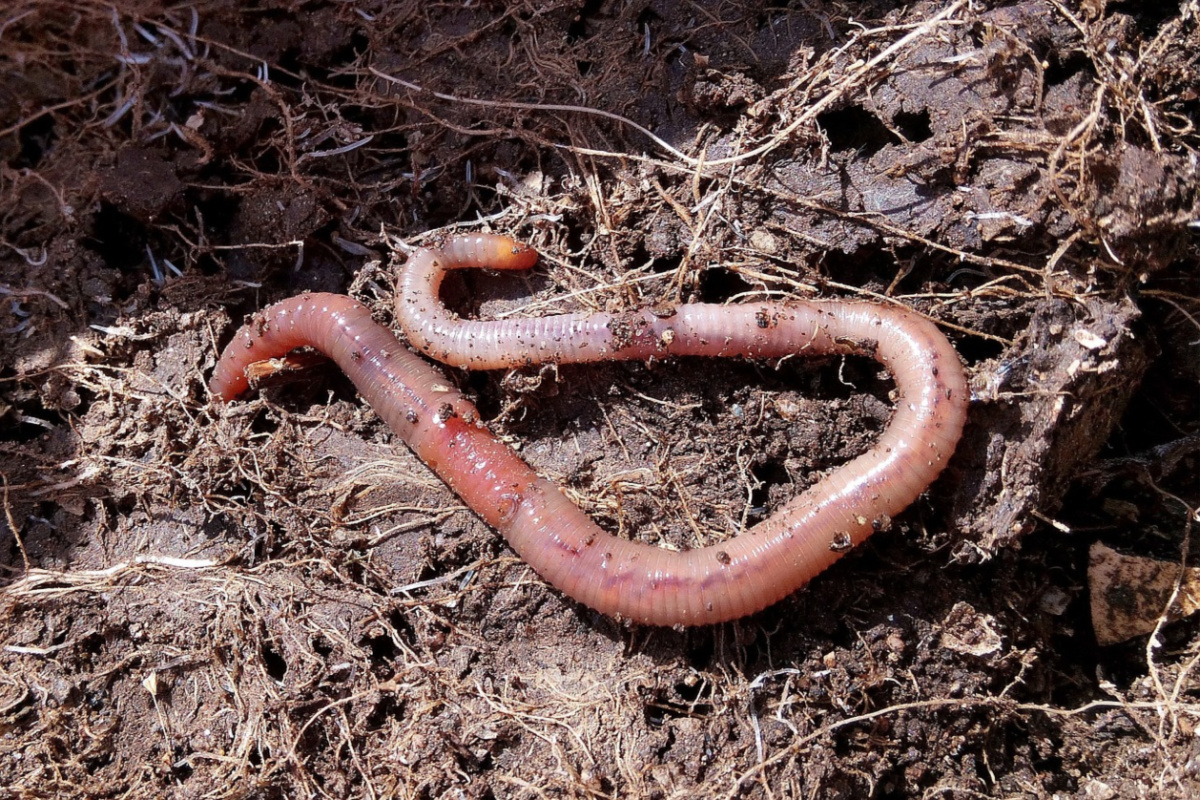
Vermicomposting
Vermicomposting is an accelerated composting process that uses worms to speed things up. Rather than waiting for bacteria and microorganisms to do the work of breaking down food waste, the worms process it and leave behind a nutrient-rich potting soil called castings. One major benefit is that you can do vermicomposting inside a small apartment, as long as you’re careful what you feed your worms.
The process uses red worms, instead of garden worms which are much more likely to want to explore and escape your composting bins. Red worms prefer to stay in one place, and churn out the best quality castings for composting. To find red worms, you can simply ask a vermicomposting friend to donate some, buy at a garden shop, or at a reasonable price online. There’s even an awesome map that lets you find local vermicomposters willing to donate worms.
Once your worms arrive, set them up in a nice bin which can be small or large, depending on how much food waste you have, and how much space you’re willing to devote. Feed them food scraps, and then add a layer of shredded paper or dry leaves. This staves off flies and odor, and the worms will eat and digest this, too.
You shouldn’t feed your worms meat or dairy, at least to start out, and especially not if you’re composting indoors or in a small space. The worms will eat it, but they’ll be slow about it, and in the meantime, they can stink the place up.
According to the EPA, “One pound of mature worms (approximately 800-1,000 worms) can eat up to half a pound of organic material per day. It typically takes three to four months for these worms to produce harvestable castings, which can be used as potting soil. Vermicomposting also produces compost or ‘worm’ tea, a high-quality liquid fertilizer for house plants or gardens.” (www.epa.gov)
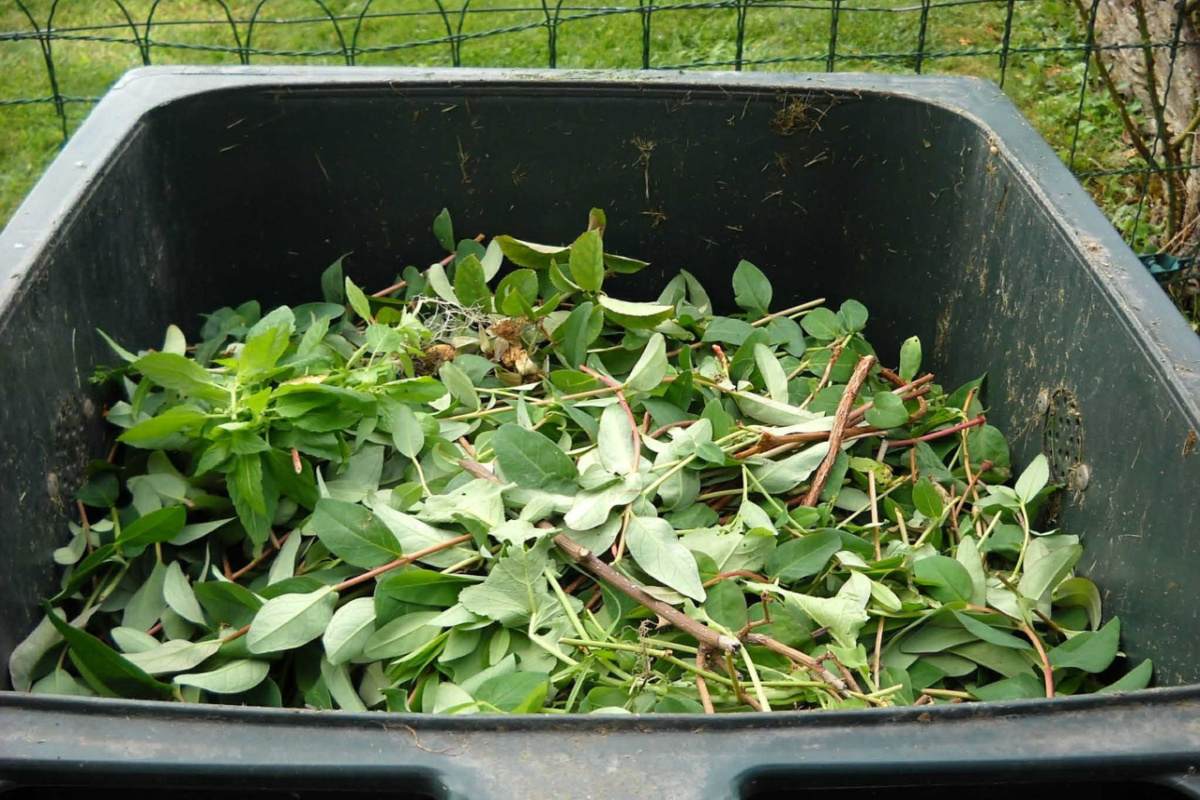
Curbside Pickup
Some towns and even private services offer curbside pickup of your compostable goods, letting you do much the same as you would for trash or recycling. They haul the food waste off and take care of it at their large, efficient composting centers. Contact your local Department of Public Works to inquire about composting opportunities. In the Boston area, Bootstrap Compost picks up buckets for residents at a reasonable rate.
In Closing,
The benefits of composting are huge, and it’s easy to get started, once you’ve learned the basics of how to compost. We here at the Herbal Academy know just how much of an impact one person can make. Imagine the impact we can all make together if we start composting this year?
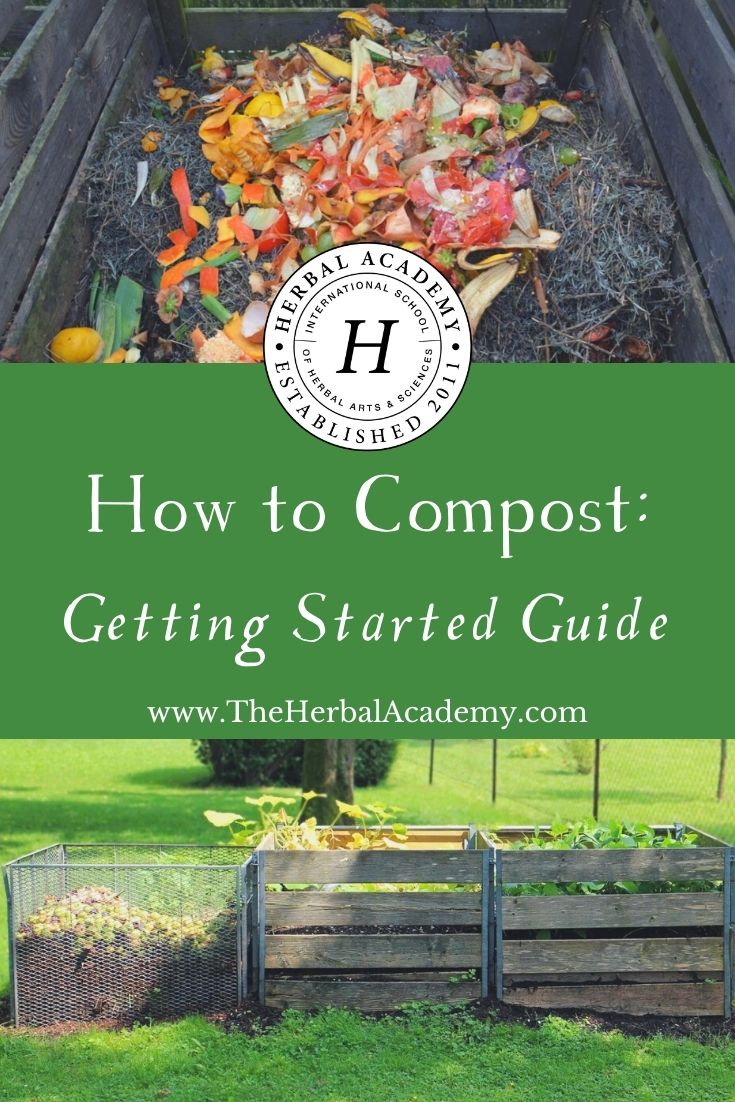
REFERENCES
Chester County Solid Waste Authority. (n.d.). Compost troubleshooting [Database]. Retrieved from https://www.chestercountyswa.org/132/Compost-Troubleshooting
Composting at Home. (2014, March 16). Retrieved from http://www2.epa.gov/recycle/composting-home
Cornell Waste Management Institute. (1996). Compost chemistry [Database]. Cornell University. Retrieved from http://compost.css.cornell.edu/chemistry.html#:~:text=Nitrogen%20is%20a%20crucial%20component,each%20of%20your%20compost%20ingredients
Hansen, W. Ecologic, Institute for International and European Environmental Policy, (2002). Eu waste policy and challenges for regional and local authorities. Retrieved from http://www.arctic-transform.eu/files/projects/2013/1921-1922_background_paper_waste_en.PDF
HGTV. (2020). How to build a DIY compost tumbler [Blog]. Retrieved from https://www.hgtv.com/outdoors/landscaping-and-hardscaping/how-to-build-a-diy-compost-tumbler
Huffstetler, E. (2019). How to make a compost bin for a trash can [Magazine]. The Spruce. Retrieved from https://www.thespruce.com/how-to-make-a-compost-bin-from-a-garbage-can-1388581#:~:text=Making%20a%20compost%20bin%20from%20a%20trash%20can,include%20leaves%2C%20twigs%2C%20wood%20chips%2C%20newspaper%2C%20and%20cardboard
Kitchen Plot. (2018). How to build a compost bin [Blog]. Retrieved from https://www.kitchenplot.com/blog/build-compost-bin-from-pallets
United States Environmental Protection Agency. (n.d). Reducing wasted food basics [Website]. Retrieved from http://www2.epa.gov/recycle/reducing-wasted-food-basics
Schwartz, J. (2014). Soil as carbon storehouse: New weapon in climate change? [Magazine]. Yale 360. Retrieved from https://e360.yale.edu/features/soil_as_carbon_storehouse_new_weapon_in_climate_fight#:~:text=Carbon%20is%20the%20main%20component,can%20last%20thousands%20of%20years
Soil Science Society of America. (n.d.). Nitrogen cycle [Database]. Retrieved from https://www.soils4teachers.org/nitrogen-cycle#:~:text=Why%20is%20Nitrogen%20so%20important,enough%20food%20(usually%20yellow)
Uncle Jim. (2016). How to make a chicken wire composter in 10 minutes [Blog]. Retrieved from https://unclejimswormfarm.com/how-make-chicken-wire-composter/
University of Maryland Extension. (2020). How to make compost at home? [Database]. Retrieved from https://extension.umd.edu/resource/how-make-compost-home
Whatcom County Extension. (n.d.). Compost fundamentals: Compost needs [Database]. Washington State University. Retrieved from http://whatcom.wsu.edu/ag/compost/fundamentals/needs_temperature.htm#:~:text=The%20optimum%20temperature%20range%20is,above%20this%20for%20extended%20periods.

